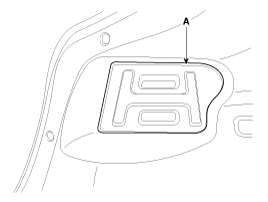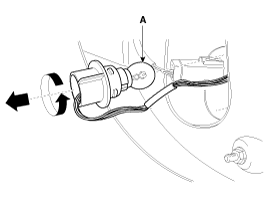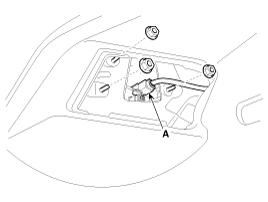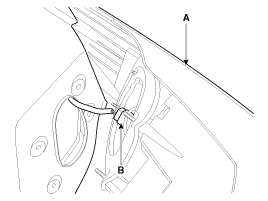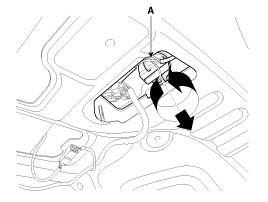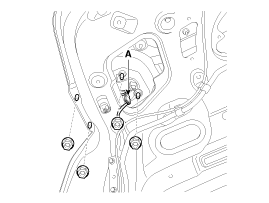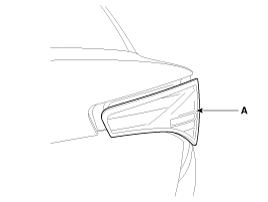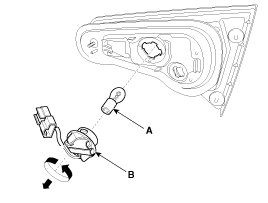Kia Optima Hybrid: Lighting System / Rear combination lamp Repair procedures
| Removal |
| 1. |
Disconnect the negative (-) battery terminal. |
| 2. |
Remove the rear combination lamp cover (A).
|
| 3. |
Replace the turn signal lamp bulbs (A) by turning it counterclockwise.
|
| 4. |
Disconnect the connector (A) and then loosen the mounting nuts.
|
| 5. |
Remove the rear combination lamp (A) after disconnecting the connector (B).
|
| 1. |
Disconnect the negative (-) battery terminal. |
| 2. |
Remove the trunk trim.
(Refer to the BD group - "Trunk") |
| 3. |
If the tail lamp bulb should be only replaced without
removing lamp assembly, replace the tail lamp bulb (A) after removing
the trim cover in the trunk.
|
| 4. |
Remove the rear lamp assembly after removing the nuts and connector (A).
|
| 5. |
Replace the back up lamp bulbs (A) by turning the sockets (B) counterclockwise.
|
| Installation |
| 1. |
Install the rear combination lamp (Inside) assembly. |
| 2. |
Install the rear combination lamp (outside) assembly. |
 High Mounted stop lamp Repair procedures
High Mounted stop lamp Repair procedures
Removal 1. Disconnect the negative(-) battery terminal. 2. Remove the rear seat. (Refer to the BD group - "Rear seat") 3. Remove the package tray trim (A). (Refer to the BD group -"Interior trim") 4. Remove ...
 Turn Signal Lamp Repair procedures
Turn Signal Lamp Repair procedures
Removal Door Mirror Turn Signal Lamp 1. Disconnect the negative (-) battery terminal. 2. Remove the mirror (C) after disconnecting the heater connector (A) and BSD warning connector (B). 3. Remove the ...
Other information:
Kia Optima Hybrid (TF HEV) 2016-2020 Service Manual: Speakers Repair procedures
Inspection 1. Troubleshooting for Speaker (1) Basic inspection of speaker Inspect the sound from speaker after verifying that the speaker mounting screws are removed and the wiring connector is connected to remove any possible vibration transmitted from body trims and surrounding parts. (2) Case Troubleshooting ...
Kia Optima Hybrid (TF HEV) 2016-2020 Service Manual: Trailing Arm Repair procedures
Replacement 1. Remove the rear wheel & tire. Tightening torque: 88.3 ~ 107.9N.m (9.0 ~ 11.0kgf.m, 65.1 ~ 79.6lb-ft) Be careful not to damage the hub bolts when removing the rear wheel & tire. 2. Loosen the bolt & nut and then remove the rear upper arm (A) from the rear axle. ...

